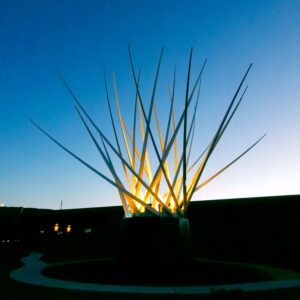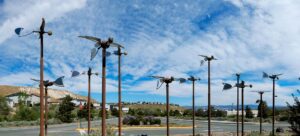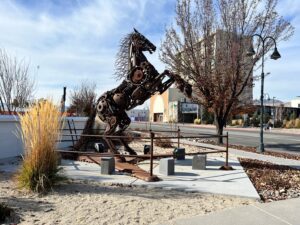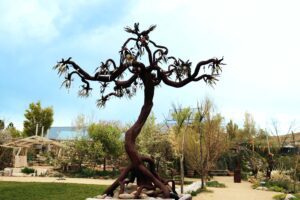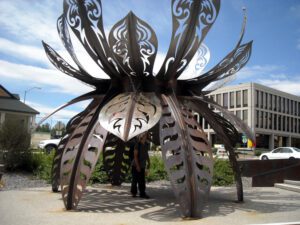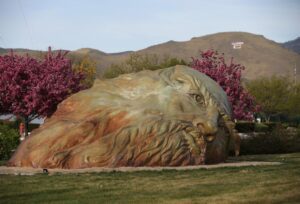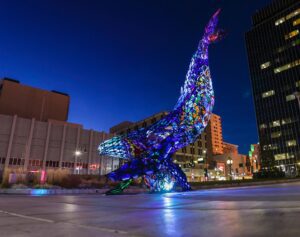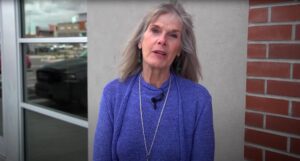Most people know that recycling benefits the environment and helps advance sustainability, but not everyone thinks about the other ways it can contribute to a more vibrant local community. In Reno, artists are reclaiming materials that would otherwise become waste and using their talent, creativity, and ingenuity to turn them into valuable pieces of art. And the city is taking notice, purchasing several of these pieces for display in public spaces in neighborhoods across the city.
In recent years, Reno has grown to fully embrace both recycling and public art. The City of Reno’s Public Art Program manages a collection of over 185 permanent and temporary works of art, which are placed throughout the city. The program also supports local artists and organizations to create public art projects that engage the community and enhance the quality of life.
“Much of our public art in Reno is built from recycled materials,” Nettie Oliverio says. As Arts and Culture Director for Reno Public Market and recipient of the EDAWN Lifetime Achievement Award for Innovation and Stewardship of the Arts, she is intimately involved in the Northern Nevada arts scene. The Reno Public Market brings together artists, craftspeople, and performers with local businesses, retailers, and food sellers to create a vibrant community gathering space. Through her passion for helping creativity thrive, Nettie is uniquely positioned to understand the significance that art can play in both being sustainable and keeping the city clean.
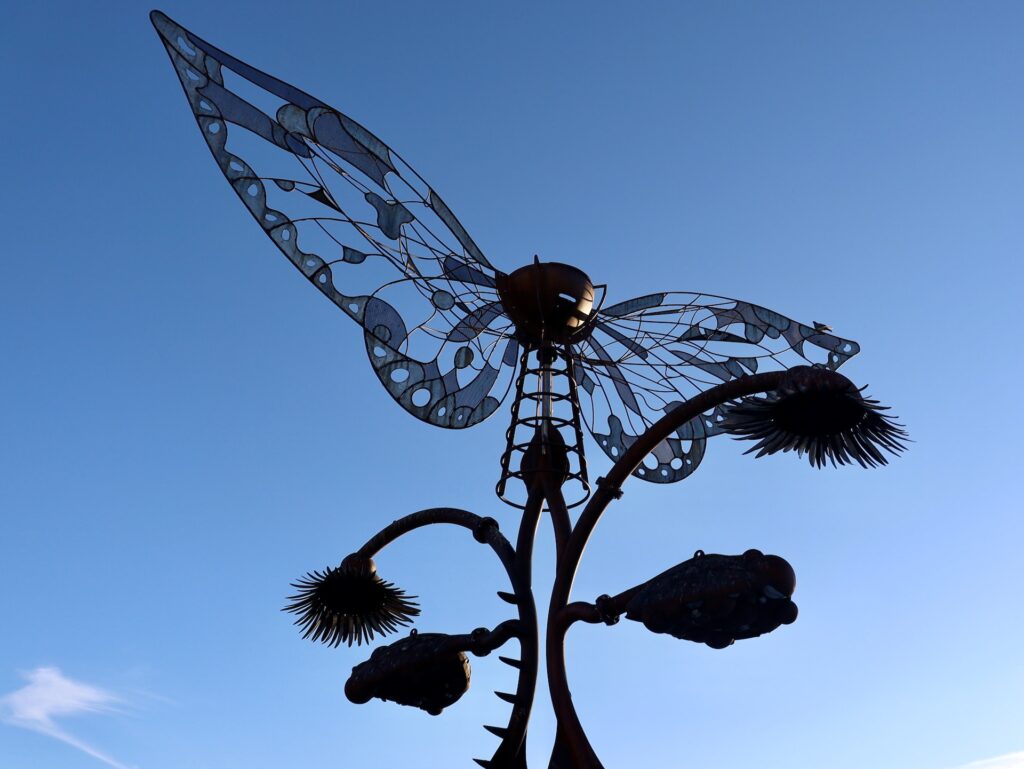
Portal of Evolution by artist Bryan Tedrick, located in Reno’s Bicentennial Park. photo by Manny Becerra.
Public art is a powerful tool that can bring communities together and foster a sense of belonging. Public art installations are often created with the intention of beautifying public spaces, but they can also serve as a means of promoting social change and raising awareness about important issues, including environmental and sustainability issues. Artwork that conveys messages about the consequences of pollution, waste, and unsustainable practices can inspire community members to take action and make more environmentally conscious choices. The work can also demonstrate how waste can be transformed into something valuable and aesthetically pleasing.
Recycled art can transform materials that are usually discarded into beautiful pieces of art that challenge our perception of what is valuable and what is not. It can also showcase the potential of recycling to create new and useful products from old and unwanted ones and demonstrate how recycling can reduce the environmental impact of our consumption habits.
Additional Benefits of Using Recycled Materials:
- Recycled materials (such as plastic, metal, paper, electronic waste, or any other found objects) are cheap (if not free) and abundant, making public art more accessible and affordable for artists and communities.
- They are diverse and versatile, allowing for a wide range of artistic expressions and styles.
- They are environmentally friendly, reducing the need for new materials and minimizing the impact on natural resources.
- They are meaningful and educational, conveying a message of sustainability and raising awareness about environmental issues.
Knowing how we can reuse or upcycle everyday waste for functional or aesthetic purposes can encourage the community to view waste as a resource rather than a burden.
RELATED: Recycled Art Projects for Kids
“Local and public art does a lot for the community I think,” says Abram Santa Cruz, whose piece “Electric Dandelions” was displayed in the city’s temporary Reno Playa Art Park. “[It] promotes collaboration and creativity on a larger scale. Inspires kids to be more creative and makes the community think differently about the use of public spaces.” And Nettie agrees: “I believe it’s important for every community to have a healthy and vibrant space for creativity to thrive.”
Art in public spaces can also help to create a sense of place and identity for a community, an effect that’s heightened when recycled materials are used. Reused, recycled, or found objects often reflect the unique character of a community. When used in public art they become reflective of the community’s commitment to sustainability, standing as a monument to that ideal. These pieces attract tourists and visitors, who not only help to boost the local economy, and may become interested in environmental issues themselves if they aren’t already.
Repurposing Burning Man Pieces
For a few weeks every year, Reno becomes a stopover for the world’s creative and artistic energy as the annual Burning Man festival takes place just a couple hours outside the city. Artists, dreamers, makers, and builders from all around the globe descend on the Northern Nevada desert with diverse works of art that transcend genre and medium to bring their creative visions to the throngs of festivalgoers. Many of those works are crafted with found, foraged, or recycled materials, reflecting the event’s focus on self-reliance, sustainability, and harmony with the world around us.
More than a decade ago, the city of Reno decided to amplify that message by becoming the first city to both temporarily and permanently display art from the Burning Man festival. The connection continues, with countless pieces of large-scale public art from the festival making their way to the streets, sidewalks, plazas, and museums, enriching communities across the city’s residential and business districts.
“Burning Man art is helping transform our city,” said Alexis Hill, former arts, culture, and events manager for the City of Reno in 2017. “When you see Burning Man art presented as public art in our community you know that you are not in ‘Anytown USA,’ you are in a unique, thriving and diverse city.”
Public Recycled Art Pieces You Can See in Reno
There are hundreds of public art pieces all around the Reno area, but if you’re specifically interested in pieces with an environmentally-focused message, here are a few pieces you won’t want to miss.
Reno Star Cosmic Thistle
Location: S Virginia St and S McCarran Blvd
This piece by artist Mark Szulgit debuted at Burning Man in 2012 and is made from repurposed salvaged steel from the city of Reno. The thistle stands 46 feet tall and 60 feet wide and its design was inspired by high desert plants found in the Great Basin. The Reno Arts and Culture Commission funded the piece through a call for artists to produce something out of steel pipe left over from a dismantled turbine project.
Gift of Flight
Location: Robb Drive Roundabout/Northwest Reno Library
David Boyer’s “Gift of Flight” is a kinetic sculpture that features 12 robotic birds made from found objects that rotate with the breeze. David Boyer regularly uses found objects in his art for the unique timeworn color and texture, the sense of nostalgia they can imbue, and for the satisfaction he gets from knowing that “something old, discarded, and forgotten has been transformed into a thing of beauty that others can enjoy.”
Rearing Horse
Location: W 4th St. and Ralston St
Sculptor Barry Crawford’s “Rearing Horse” debuted at Burning Man in 2018 and now stands at the corner of W 4th St. and Ralston St. Constructed out of a combination of found objects and new metal, this 14.5-foot tall kinetic sculpture can stand on its hind legs and its movement is powered by cranks on the perimeter fence.
Pan’s Perch
Location: River School Farm
Ryan Jackson’s scrap metal tree bearing lotus flowers and fruit was originally created for Burning Man in 2007, but it’s now firmly rooted at the River School Farm. It was conceived as a place to contemplate our impact on the natural world. Jackson finds deep satisfaction in using the waste material from the steel shops that he works in and hopes that people see through his work that “scrap” can be made into something beautiful.
Guardian of Eden
Location: Truckee Meadows Community College
Kate Raudenbush’s scrap metal sculpture serves as a meditation on earth, climate, and sustainability. Raudenbush said about her own piece, “Among the intricately carved lotus petals high above the earth, each visitor becomes the symbolic embodiment of the lotus’s pollen: the vital ecological information carriers of every flower.” The piece is part of the Nevada Museum of Art’s Contemporary Art collection, but can currently be seen on display at TMCC’s Dandini Campus.
Inside the Mind of Da Vinci
Location: Carson City Community Center
Artist Mischell Riley originally created this impressive piece for Burning Man in 2016. Made from reinforced acid-stained concrete, recycled glass, and steel, it was envisioned as a community spot for gathering and sharing artistic and inventive ideas. Once displayed on the lawn of the University of Nevada Reno, this 10 by 23-foot sculpture of Leonardo da Vinci’s head now rests outside the Community Center in nearby Carson City.
Space Whale
Location: City Plaza on N. Virginia St.
One of the most recognizable pieces of public art to come to Reno in recent years, the “Space Whale”, first descended on the playa in 2016 and can now be found right near the Truckee River at City Plaza. While this piece may not be made of recycled materials, its message about our responsibility to preserve nature makes it a poignant statement about our impact on the natural world around us.
These are just a few examples of how recycling can help create a vibrant local community through public art. Reuse and recycling helps to protect the environment and enrich our culture and society with creative innovation, bringing us together for a common cause.

